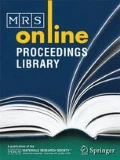Abstract
The dynamic fracture of concrete in tension is studied by applying a continuum damage model developed by the author and his coworkers [1–3]. In this model, the degree of damage in concrete corresponds to the fraction of concrete volume that has been tension relieved, and tensile microcracking has been taken as the damage mechanism. In compression, the concrete is assumed to respond in an elastic/perfectly plastic manner. Strain-rate effects have been explicitly included in the model. Accumulation of damage in the material is reflected by the progressive weakening of the material stiffness. Examples involving center- and edge-cracked plate specimens subjected to the action of step and ramp loads are used to demonstrate the material responses predicted by the model. The bulk pressure versus strain relationships at locations close to the crack tip clearly show strain-softening behavior. The damage tends to localize around the crack and its extent in the specimen is dependent upon both the crack geometry and the loading type. These results are presented and their implications are discussed.
Similar content being viewed by others
References
Taylor, L. M. and Chen, E. P., Damage Accumulation in Rock Due to Explosive Loading, Proceedings of the 21st Annual Meeting of the Society of Engineering Science, Blacksburg, VA, 1984.
Taylor, L. M., Chen, E. P., and Kuszmaul, J. S., Microcrack Induced Damage Accumulation In Brittle Rock Under Dynamic Loading, To be published in the Journal of Computer Methods in Applied Mechanics and Engineering.
Chen, E. P. and Taylor, L. M., Fracture of Brittle Rock Under Dynamic Loading Conditions, Proceedings of the 4th International Symposium on the Fracture Mechanics of Ceramics, in print.
Hallquist, J. O., User’s Manual for DYNA2D — An Explicit Two-Dimensional Hydrodynamic Finite Element Code With Interactive Rezoning, Lawrence Livermore National Laboratory Report UCRL-52997, Livermore, CA, 1981.
Budiansky, B. and O’Connell, R. J., Elastic Moduli of a Cracked Solid, International Journal of Solids and Structures, Vol. 12, pp. 81–97, 1976.
Grady, D. E. and Kipp, M. E., Continuum Modeling of Explosive Fracture in Oil Shale, International Journal of Rock Mechanics and Mining Sciences, Vol. 17, pp.147–157, 1980.
Grady, D E., The Mechanics of Fracture Under High-Rate Stress Loading, Preprints of the William Prager Symposium on Mechanics of Geomaterials: Rocks, Concrete and Soils, Edited by Z. P. Bazant, Northwestern University, Evanston, IL, 1983.
Kipp, M. E., Grady, D. E., and Chen, E. P., Strain-Rate Dependent Fracture Initiation, International Journal of Fracture, Vol. 16, pp. 471–478. 1980.
Sih, G. C., Handbook of Stress Intensity Factors, Lehigh University, Bethlehem, Pennsylvania, 1973.
Author information
Authors and Affiliations
Additional information
This work performed at Sandia National Laboratories is supported by the U.S. Department of Energy under Contract Number DE-AC04-76D00789.
Rights and permissions
About this article
Cite this article
Chen, E.P. Continuum Damage Mechanics Studies on the Dynamic Fracture of Concrete. MRS Online Proceedings Library 64, 63–77 (1985). https://doi.org/10.1557/PROC-64-63
Published:
Issue Date:
DOI: https://doi.org/10.1557/PROC-64-63




